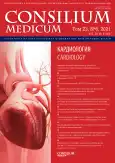Injury of vascular endothelium and erythrocytes in COVID-19 patients
- Authors: Buryachkovskaya L.I.1, Melkumyants A.M.1, Lomakin N.V.2, Antonova O.A.1, Ermiskin V.V.1
-
Affiliations:
- National Medical Research Center of Cardiology
- Central Clinical Hospital with a Polyclinic
- Issue: Vol 23, No 6 (2021)
- Pages: 469-476
- Section: Articles
- URL: https://journals.rcsi.science/2075-1753/article/view/95474
- DOI: https://doi.org/10.26442/20751753.2021.6.200939
- ID: 95474
Cite item
Full Text
Abstract
Full Text
##article.viewOnOriginalSite##About the authors
Liudmila I. Buryachkovskaya
National Medical Research Center of Cardiology
Email: livbur@mail.ru
д-р биол. наук, вед. науч. сотр. Moscow, Russia
Arthur M. Melkumyants
National Medical Research Center of Cardiologyд-р биол. наук, проф., вед. науч. сотр. Moscow, Russia
Nikita V. Lomakin
Central Clinical Hospital with a Polyclinic
Email: lomakinnikita@gmail.com
д-р мед наук, гл. внештат. специалист-кардиолог Moscow, Russia
Olga A. Antonova
National Medical Research Center of Cardiologyнауч. сотр. Moscow, Russia
Vladimir V. Ermiskin
National Medical Research Center of Cardiologyканд. биол. наук, вед. науч.сотр. Moscow, Russia
References
- Zhu N, Zhang D, Wang W, et al. A novel coronavirus from patients with pneumonia in China. 2019. N Engl J Med. 2020;382(8):727-33. doi: 10.1056/NEJMoa2001017
- Ackermann M, Verleden SE, Kuehnel M, et al. Pulmonary vascular endothelialitis, thrombosis, and angiogenesis in COVID-19. N EnglJ Med. 2020;383(2):120-8. doi: 10.1056/NEJMoa2015432
- Thompson BT, Chambers RC, Liu KD. Acute respiratory distress syndrome. N Engl J Med. 2017;377(6):562-72. doi: 10.1056/NEJMra1608077
- Zaim S, Chong JH, Sankaranarayanan V, Harky A. COVID-19 and multi-organ response. Curr Probl Cardiol. 2020;45(8):100618. doi: 10.1016/j.cpcardiol.2020.100618
- Kochi AN, Tagliari AP, Forleo GB, et al. Cardiac and arrhythmic complications in patients with COVID-19. J Cardiovasc Electrophysiol. 2020;31(5):1003-8. doi: 10.1111/jce.14479
- Маев И.В., Шпектор А.В., Васильева Е.Ю., и др. Новая коронавирусная инфекция COVID-19: экстра пульмональные проявления. Терапевтический архив. 2020;92(8):4-11 [Maev IV, Shpektor AV, Vasilyeva EYu, et al. Novel coronavirus infection COVID-19: extrapulmonary manifestations. Terapevticheskii Arkhiv (Ter. Arkh.). 2020;92(8):4-11 (in Russian)]. doi: 10.26442/00403660.2020.08.000767
- Zhai Z, Li C, Chen Y, et al. Prevention and treatment of venous thromboembolism associated with coronavirus disease 2019 infection: a consensus statement before guidelines. Thromb Haemost. 2020;120(6):937-48. doi: 10.1055/s-0040-1710019
- Batlle D, Soler MJ, Sparks MA, et al. Acute kidney injury in COVID-19: emerging evidence of a distinct pathophysiology. JASN. 2020;31(7):1380-3. doi: 10.1681/ASN.2020040419
- Zhang C, Shi L, Wang FS. Liver injury in COVID-19: management and challenges. Lancet Gastroenterol Hepatol. 2020;5(5):428-30. doi: 10.1016/S2468-1253(20)30057-1
- Sepehrinezhad A, Shahbazi A, Negah SS. COVID-19 virus may have neuroinvasive potential and cause neurological complications: a perspective review. J Neurovirol. 2020;26:324-9. doi: 10.1007/s13365-020-00851-2
- Varga Z, Flammer AJ, Steiger P, et al. Endothelial cell infection and endotheliitis in COVID-19. Lancet. 2020;395(10234):1417-8. doi: 10.1016/S0140-6736(20)30937-5
- O'Sullivan J.M., Mc Gonagle D., Ward S.E., et al. Endothelial cells orchestrate COVID-19 coagulopathy. Lancet Haematology. 2020;7(8):e553-5. doi: 10.1016/S2352-3026(20)30215-5
- Воробьев П.А., Момот А.П., Зайцев А.А., и др. Синдром диссеминированного внутрисосудистого свертывания крови при инфекции COVID-19. Терапия. 2020;6(5):25-34
- Hoffmann M, Kleine-Weber H, Schroeder S, et al. SARS-CoV-2 cell entry depends on ACE2 and TMPRSS2 and is blocked by a clinically proven protease inhibitor. Cell. 2020;181(2):271-80.e8. doi: 10.1016/j.cell.2020.02.052
- Патологическая анатомия COVID-19. Атлас. Под ред. О.В. Заратьянца. М.: ГБУ «НИИОЗММ ДЗМ», 2020
- Guan WJ, Ni ZY, Hu Y, et al. Clinical characteristics of coronavirus disease 2019 in China. N Engl J Med. 2020;382(18):1708-20. doi: 10.1056/NEJMoa2002032
- Haddad G, Bellali S, Fontanini A, et al. Rapid scanning electron microscopy detection and sequencing of severe acute respiratory syndrome Coronavirus 2 and other respiratory viruses. Front Microbiol. 2020;11:596180. doi: 10.3389/fmicb.2020.596180
- Hladovec J, Rossmann P Circulating endothelial cells isolated together with platelets and the experimental modification of their counts in rats. Ihromb Res. 1973;3(6):665-74. doi: 10.1016/0049-3848(73)90014-5
- Lanuti P, Simeone P, Rotta G, et al. A standardized flow cytometry network study for the assessment of circulating endothelial cell physiological ranges. Sci Rep. 2018;8(1):5823. doi: 10.1038/s41598-018-24234-0
- Furchgott RF, Zawadzki JV. The obligatory role of endothelial cells in the relaxation of arterial smooth muscle by acetylcholine. Nature. 1980;288(5789):373-6.
- Teijaro JR, Walsh KB, Cahalan S. Endothelial cells are central orchestrators of cytkine amplification during influenza virus infection. Cell. 2011;146(6):980-91. doi: 10.1016/j.cell.2011.08.015
- Wang H, Ma S. The cytokine storm and factors determining the sequence and severity of organ dysfunction in multiple organ dysfunction syndrome. Amer J Emerg Med. 2008;26(6):711-5. doi: 10.1016/j.ajem.2007.10.031
- Hamming I, Timens W, Bulthuis MLC, et al. Tissue distribution of ACE2 protein, the functional receptor for SARS coronavirus. A first step in understanding SARS pathogenesis. J Pathol. 2004;203(2):631-7. doi: 10.1002/path.1570
- Fraga-Silva RA, Sorg BS, Wankhede M. ACE2 activation promotes antithrombotic activity. Mol Med. 2010;16(5):210-5. doi: 10.2119/molmed.2009.00160
- Dignat-George F, Sampol J. Circulating endothelial cells in vascular disorders: new insights into an old concept. Eur J Haematol. 2000;65(4):215-20. doi: 10.1034/j.1600-0609.2000.065004215.x
- Fadini GP, Avogaro A. Cell-based methods for ex vivo evaluation of human endothelial biology. Cardiovasc Res. 2010;87(1):2-21. doi: 10.1093/cvr/cvq119
- Moussa MD, Santonocito C, Fagnoul D. Evaluation of endothelial damage in sepsis-related ARDS using circulating endothelial cells. Intensive Care Med. 2015;41(2):231-8. doi: 10.1007/s00134-014-3589-9
- Mancuso P, Gidaro A, Gregato G, et al. Circulating endothelial progenitors are increased in COVID-19 patients and correlate with SARS-CoV-2 RNA in severe cases. J Thromb Haemost. 2020;18(10):2744-50. doi: 10.1111/jth.15044
- Guervilly C, Burtey S, Sabatier F. Circulating endothelial cells as a marker of endothelial injury in severe COVID-19. J Infect Dis. 2020;222(11):1789-93. doi: 10.1093/infdis/jiaa528
Supplementary files






